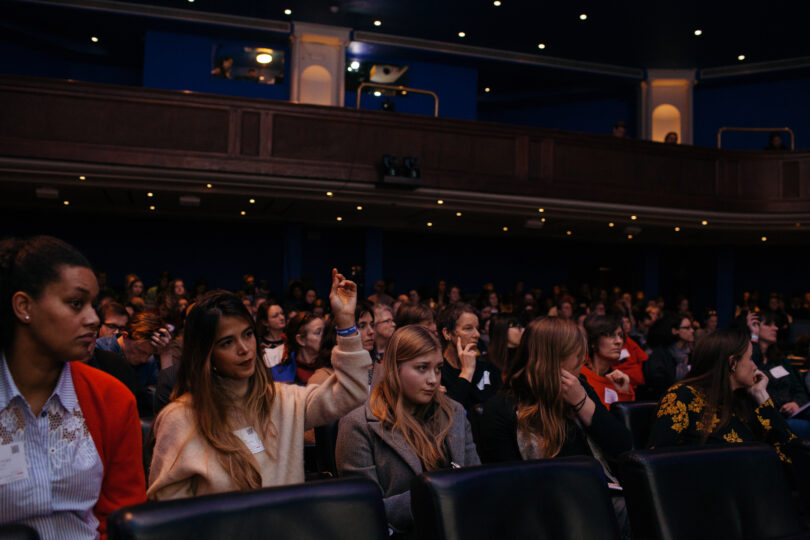- Posted on March 3rd, 2020
We Make Tomorrow: Answering your questions

Thanks for all the great questions that you submitted via Sli.do and sorry we couldn’t get to more of them throughout the day. Some of them will feed directly into our future work, and some we will look to answer over the coming weeks. Here’s a first few:
What can museums and galleries concretely begin doing right now to limit their carbon footprint?
Check out the free Museums’ Environmental Framework developed by Julie’s Bicycle with the support of Arts Council England and in consultation with sector organisations, including: Happy Museum Project; Museum Development Network; Museums Galleries Scotland; Museums, Archives and Libraries Division Welsh Government; Northern Ireland Museums Council and; Sustainable Exhibitions for Museums. Lots of stories and ideas!
Is there an official accreditation that requires culture businesses to comply with certain targets before they can virtue signal their climate responsibility?
The Julie’s Bicycle Creative Green Certification assesses the environmental performance of venues, festivals, museums, galleries, events, and offices. Organisations are awarded between one and five stars based on points awarded for commitment, understanding and improvement. It is only possible to achieve the highest points by demonstrating GHG emissions reductions (in the improvement category).
For larger organisations, we are working on creating targets in line with the Science-BasedTargets initiative framework through programmes like Arts Council England Spotlight programme and bespoke Creative Green consultancy projects.
We will also be shortly launching a Creative Green Mark for the needs of smaller organisations, or those just starting out – watch this space!
How and where can smaller culture and arts organisations seek support to help them take practical action to address the climate emergency?
Julie’s Bicycle publishes lots of free guides and factsheets on topics such as sustainable events, buying green energy, biodiversity, business travel, and more. We also run a programme of free webinars.
Have a scroll through our Resource Hub or use the website search function to look for information on specific topics. If you want to be the first to hear about new resources, case studies, webinars or events, sign up to the JB newsletter.
There’s lots of support and advice available around buildings management – what support and advice is there around travel and transport?
Have a look at:
· Audience travel guide (2015)
· Business travel guide (2015)
You can also use the Creative Green Tools to track the impacts of your touring (via the Touring tool) and business travel (via the Office tool).
For an even more in-depth look at touring, check out our Moving Arts research from 2010:
· Theatres
· Bands
Last and definitely not least, we’re working on a new and updated guide to travel and what the deal is with offsetting anyway.
Who’s up for offering free tickets to people who rock up and can prove they walked or cycled to the venue rather than using a car? Or even just a free drink?
Incentives are a powerful way to help shift people’s behaviour and it would be great to see more of this across the board!
There’s lots of stories from festivals and events rewarding people who use public transport, cycle, or go by coach – there’s plenty of examples in the Travel chapter of The Show Must Go On report, and in this report on audience travel.
We also know of venues that have negotiated discounts or even free travel on their local public transport networks – for example, if you have a ticket to a show at Sage Gateshead you also get free metro travel for 2 hours either side of the start and end time of the event.
How do we break out of the environmental bubble? Should we mobilise to help floodstruck towns where the poorest people are feeling climate impacts for real?
This can be very powerful and we’re really interested in the role that the arts, venues, and artists can play in building local and community resilience – both in preparing communities for climate chaos eventualities, and in stepping in to support relief efforts. Here are just some examples:
· Nawi Collective – a black womxn and non-binary femmes vocal collective based in London who used their musical platform after Cyclone Idai to support communities in Malawi with immediate aid, and also to build permaculture based infrastructure in a vulnerable rural village.
Refuge by Arts House Melbourne – bringing together local residents, artists, scientists, emergency services to explore responses to different climate disasters e.g. imagining local floods, or consecutive days over 40C.
· Test Sites by Arts Catalyst – bringing together artists, scientists, and the local community to co-explore issues like water governance and flooding.
· How the Hebden Bridge Trades Club became a lifeline for the community during 2016’s flooding.
· Rallying around fundraisers to help relief efforts; most recently a 2-day concert has been announced to raise funds for communities hit by flooding in Wales
· In the Netherlands, Open-House worked with the Netherlands Red Cross and music festivals to trial technologies and services on site at events that could be deployed in humanitarian contexts like refugee camps.
Photo credit James Allan, as part of Julie’s Bicycle’s We Make Tomorrow event

